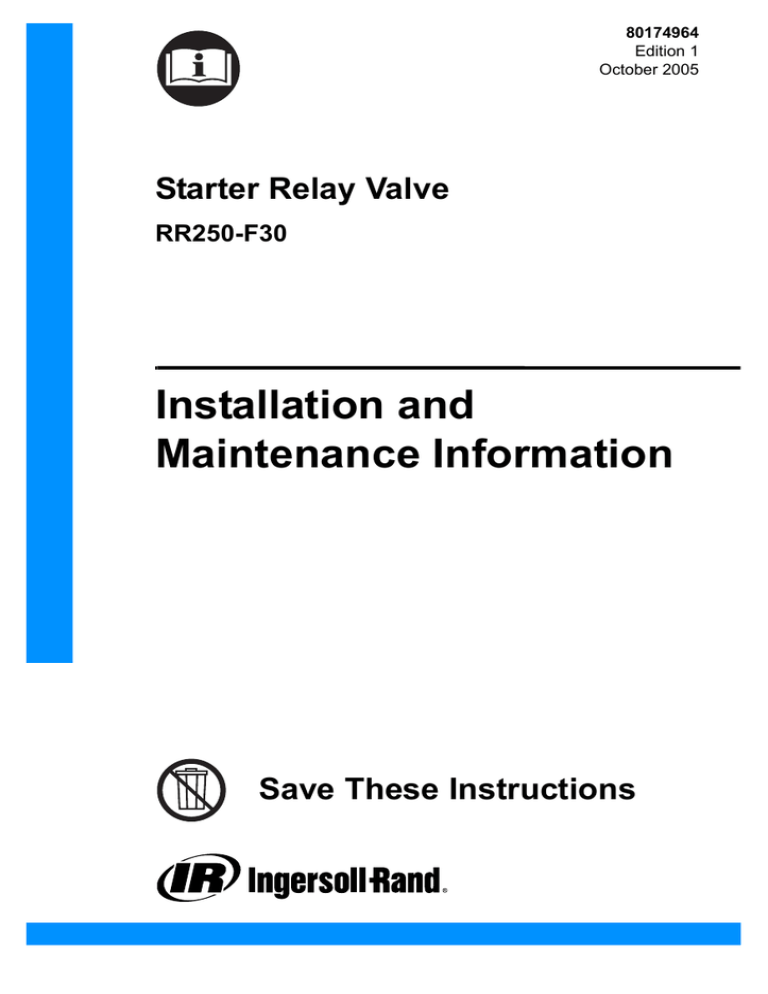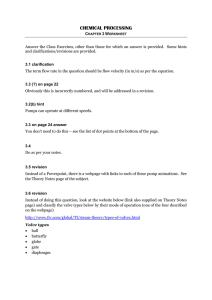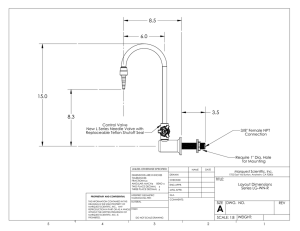Installation and Maintenance Information, Model RR250
advertisement

80174964 Edition 1 October 2005 Starter Relay Valve RR250-F30 Installation and Maintenance Information Save These Instructions WARNING General Product Safety Information • • • Important Safety Information enclosed. Read and understand this manual before operating this valve. It is your responsibility to make this safety information available to others that will operate this valve. Safety Information - Explanation of Safety Signal Words DANGER Indicates an imminently hazardous situation which, if not avoided, will result in death or serious injury. WARNING Indicates a potentially hazardous situation which, if not avoided, could result in death or serious injury. CAUTION Indicates a potentially hazardous situation which, if not avoided, may result in minor or moderate injury or property damage. NOTICE Indicates information or a company policy that relates directly or indirectly to the safety of personnel or protection of property. WARNING Failure to observe the following warnings could result in injury • • • • Do not use this Starter Relay Valve with natural gas or other flammable gases. Always bleed off the air pressure before attempting to remove the Starter Relay Valve from the Receiver or before attempting to perform any maintenance on the Starter Relay Valve. Never attempt to disassemble the Starter Relay Valve until after the air pressure has been bled off. Otherwise internal parts of the Starter Relay Valve will be blown out with the great force. Always wear eye protection when installing, removing or performing maintenance on this Starter Relay Valve. NOTICE This Starter Relay Valve is specially designed and manufactured by Ingersoll-Rand for use on Starter installations. Install it according to the following instructions: Assembling Relay Valve on starter The Relay Valve must be connected with two flanges SAE 3000 - DN 2” 1/2. NOTICE The use of other than genuine Ingersoll-Rand replacement parts may result in safety hazards, decreased starter relay valve performance and increased maintenance and will invalidate all warranties. Ingersoll-Rand is not responsible for customer modification of valve for applications on which Ingersoll-Rand was not consulted. Repairs should be made only by authorized, trained personnel. Consult your nearest Ingersoll-Rand Authorized Servicenter. 2 80174964_ed1 Specifications ILLUSTRATION REQUIRED (Dwg. 80183411) 2-1/2” Æ RR250-F30 - Order part number 16675845 Max. Inlet Pressure 30 Bar Max. Outlet Pressure 10 Bar 145 psi 1600 dm3/s 3400 scfm Max. Temperature 80°C 176°F Min. Temperature -25°C -13°F Max. Flow 80174964_ed1 435 psi 3 Description The RR250-F30 includes valve and regulator functions. The RR250 is made of three main components: 1. The master regulator which sets the pilot pressure. 2. The solenoid valve which will open or close the system when the operator actuates the switch key. 3. The slave regulator which is the main body. 3 2 The Slave regulator using the pressure signal on top of the diaphragm will force the piston off its seat. That allows air to flow into control chamber below the diaphragm, through the outlet port of the RR250 valve to the starter motor. Outlet pressure increases in the downstream system and sensing chamber (under the diaphragm) and applies an upward force on the bottom of the diaphragm. The diaphragm and piston move upward. Upward movement stops when the forces below the diaphragm balance the force above the diaphragm. 1 (Dwg. 80177892) The slave regulator (3) will receive the signal from the master regulator (1) through the solenoid valve (Fig 2). For pre-engage Starters (Fig 1) the signal pressure will come from the master regulator through the solenoid valve to the pilot “In” port of the air starter drive housing, giving the signal to engage the drive pinion into the ring gear. After engaging the drive pinion it will come out through the “Out” port of the drive housing and will go to the top cover of the slave regulator. Figure 1 (Dwg. 80177959) Figure 2 (Dwg. 80177900) (Dwg. 80177991) 4 80174964_ed1 Operation Clockwise rotation of screw (1) will open the seat in the master regulator and will increase the pressure between the master regulator and solenoid valve (4). Do not try to exceed 11 bar or 160 psig. The pressure you adjust at the slave regulator will be slightly higher than the working pressure at the starter. In order to easily adjust the working pressure install a gauge on port (2). 1 4 2 (Dwg. 80177215) The master pressure regulator is designed as a relieving regulator. When the pressure below the diaphragm reaches 1.5 bars over the adjusted pressure, the regulator exhausts the excess pressure. Schematic For inertia drive applications: For pre-engaged drive applications: (Dwg. 80177223) 80174964_ed1 5 Relay Valve Assembly Drawing 19 18 17 15 13 28 27 6 11 14 16 12 4 3 5 2 10 9 32 20 29 24 30 31 33 1 26 25 (Dwg. 80177843) Relay Valve Parts List Item 6 Parts Description Part Number Item Parts Description Part Number 1 Cover Screw (10) 38632121 29 Plug 118126 2 Diaphragm Cover 38747887 30 Plug 80162225 3 Diaphragm 38747895 31 Nipple 80162233 4 Diaphragm Support 38747853 32 Nipple 80162217 6 Housing 38747788 33 Adapter 38754933 9 Set Screw 80172745 * Piston Kit 38750956 10 Ring 38749990 18 Bottom Cover 38747796 Stem - Item no. 5 19 Bottom Cover Screw (8) 38632121 Plate - Item no. 12 20 Plug 38648192 Piston Assembly - Item no. 13 24 Mini Regulator 10548774 O-ring - Item no. 14 25 Operator and Coil 49828460 Locknut - Item no. 15 26 Solenoid Valve 49828692 Spring - Item no. 16 27 Flange Seal 38752366 O-ring - Item no. 11 28 Filter 38752333 O-ring - Item no. 17 (For RR250-F30) 80174964_ed1 Maintenance Disassembly of Relay Valve 1. Remove screws (1). Remove cover (2) and diaphragm (3). 2. WARNING: Bottom cover (18) is spring-loaded. Clamp relay valve in arbor press before removing bottom screws (19). Otherwise personal injury or damage to parts may occur. Secure relay valve upside down in arbor press, applying force to bottom cover. 3. Remove screws (19). Slowly raise arbor press to remove cover (18). 4. To remove stem piston assembly: Hold diaphragm support (4) with a spanner wrench. Turn locknut (15) with a socket to unscrew the stem from the diaphragm support. 5. If the locknut comes loose before the diaphragm support, separate the piston (13), plate (12) and stem (5). Hold the stem on the flats and unscrew the diaphragm support. 80174964_ed1 Assembly of Relay Valve Apply Parker O-Lube grease to O-rings (11), (14), and (17), and spring (16). Clean with isopropyl alcohol and apply Loctite® 242 or 243 to screws (1), screws (19), and diaphragm support (4). 1. Insert stem (5) of stem/piston assembly through ring (10) and O-ring (11) in housing (6). 2. Tighten diaphragm support (4) on stem piston assembly to 7.9/6.7 Nm (70/60 inch-Lbs) by holding locknut (15). 3. WARNING: Bottom cover (18) is spring-loaded. Clamp relay valve in arbor press before installing bottom screws (19). Otherwise personal injury or damage to parts may occur. Secure relay valve upside down in arbor press. Align bottom cover and apply force to bottom cover. 4. Install eight screws (19). Tighten to 30/26 Nm (270/230 inch-Lbs). 5. Install diaphragm (3) and cover (2). 6. Install twelve screws (1). Tighten to 25/20 Nm (220/180 inch-Lbs). 7 www.irtools.com © 2005 Ingersoll-Rand Company


